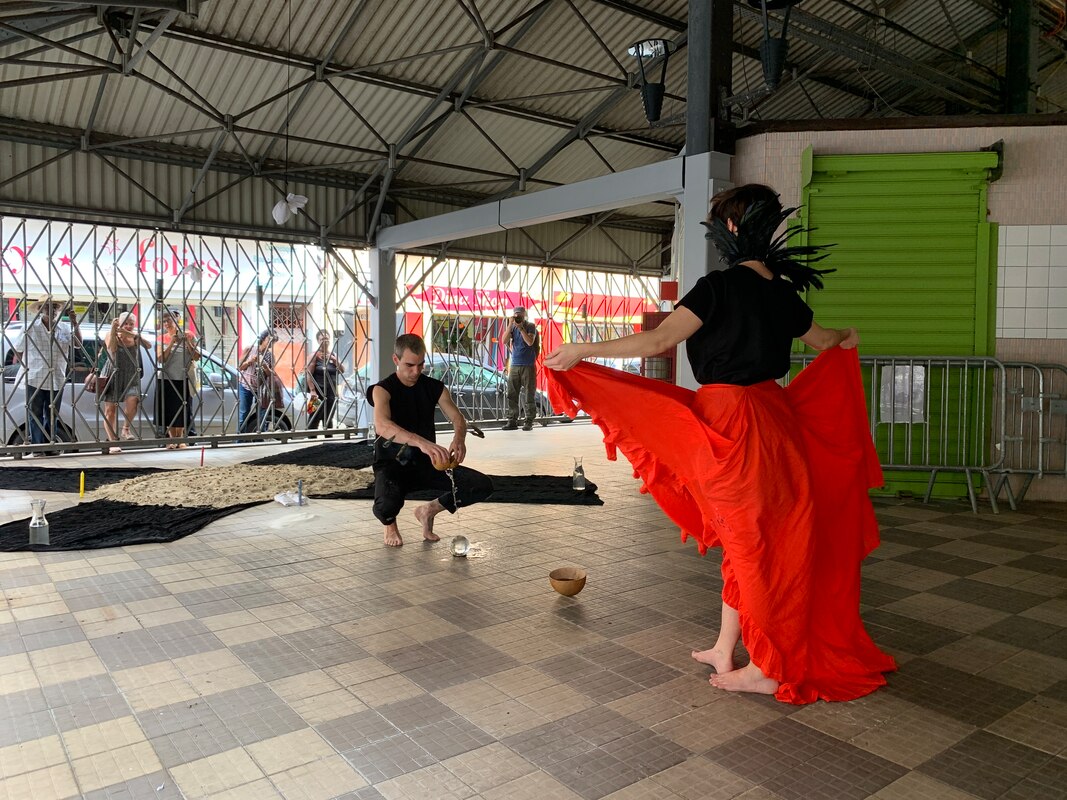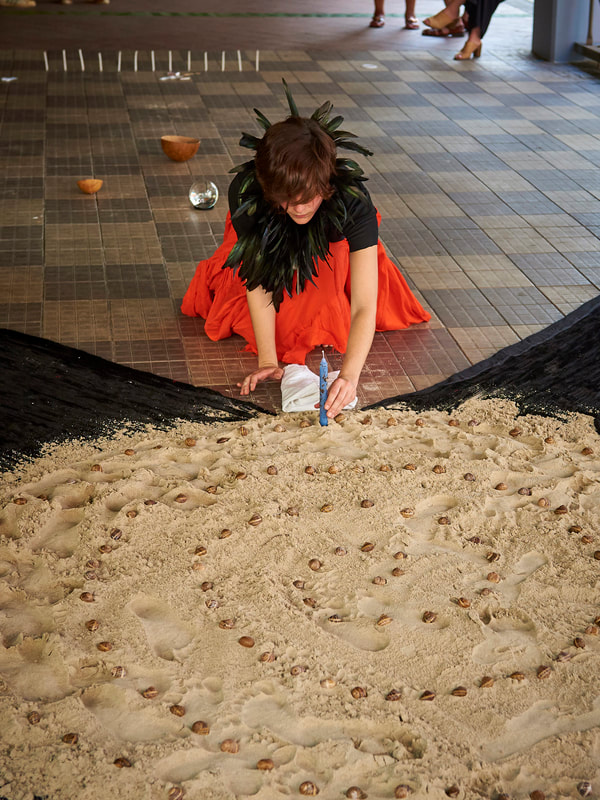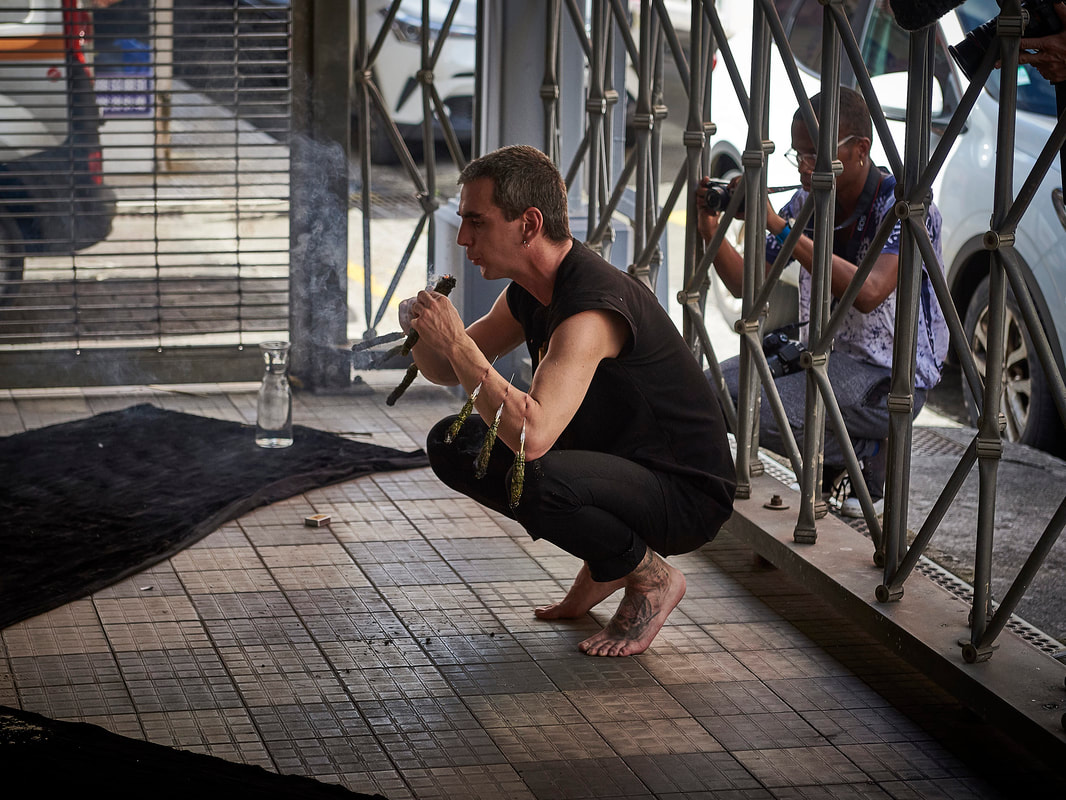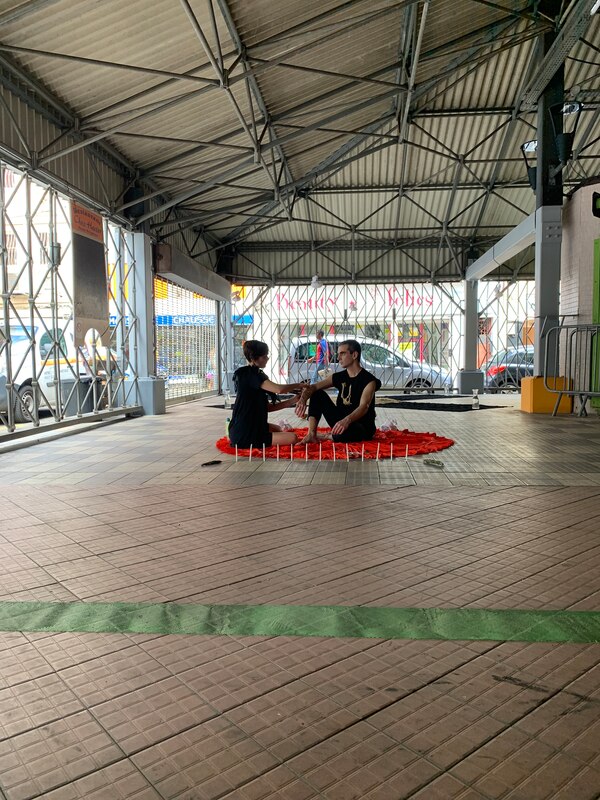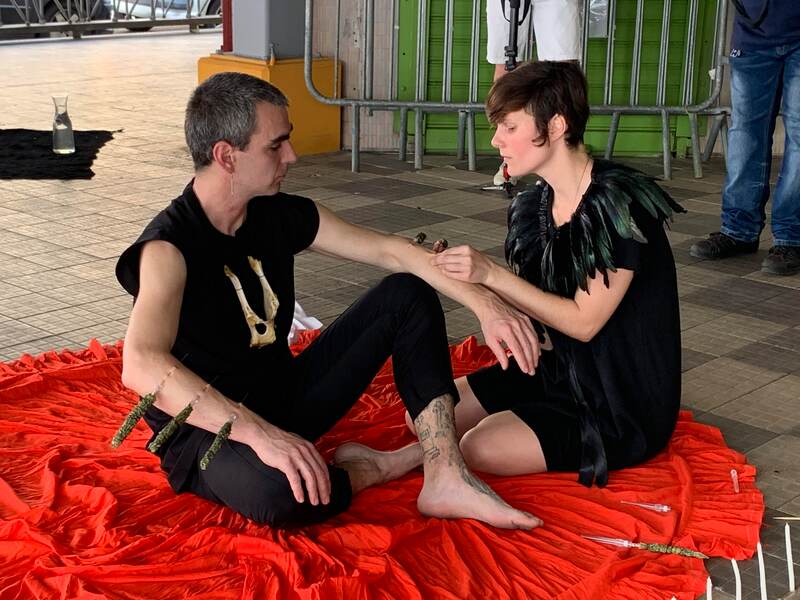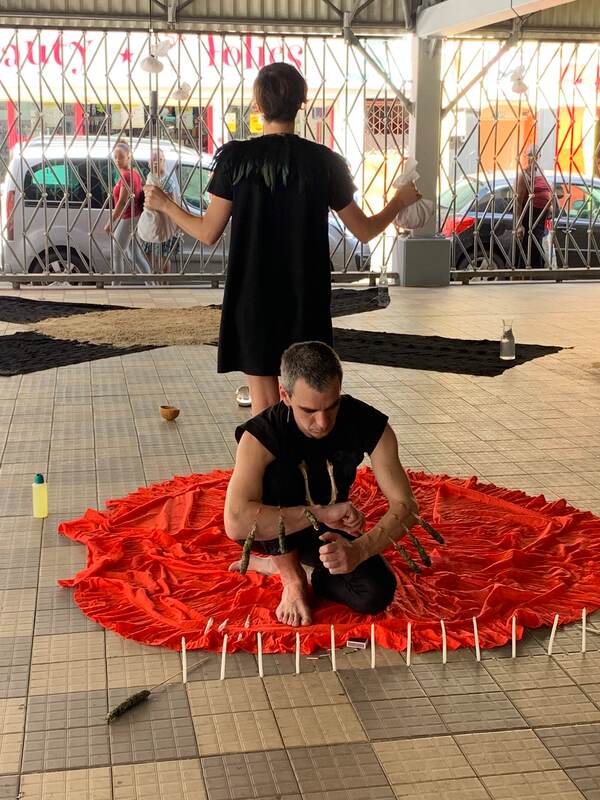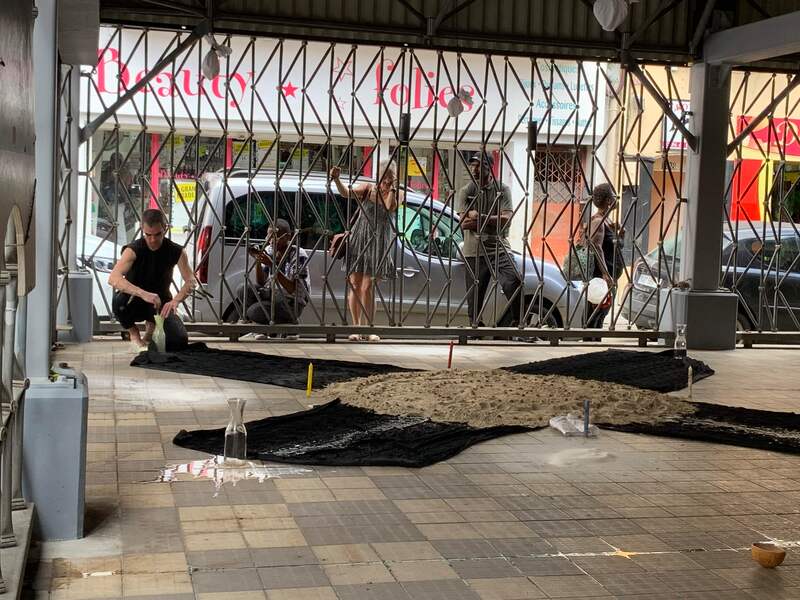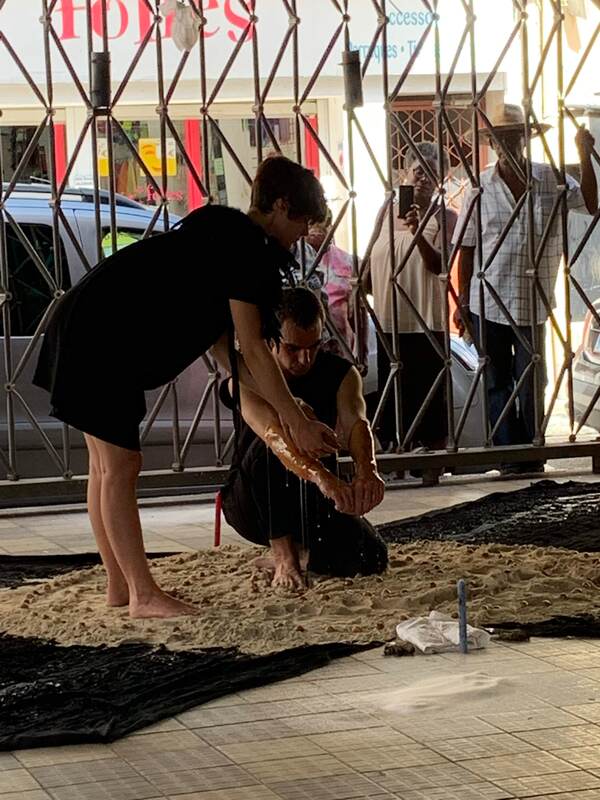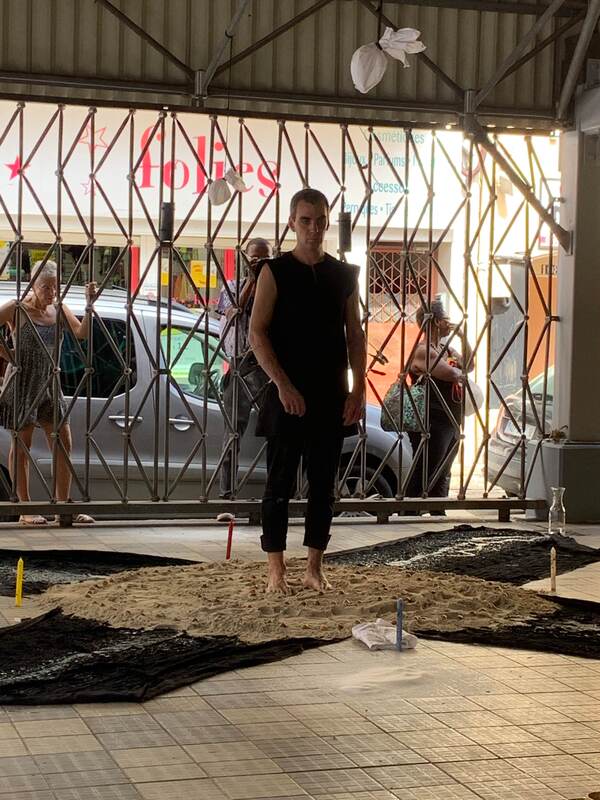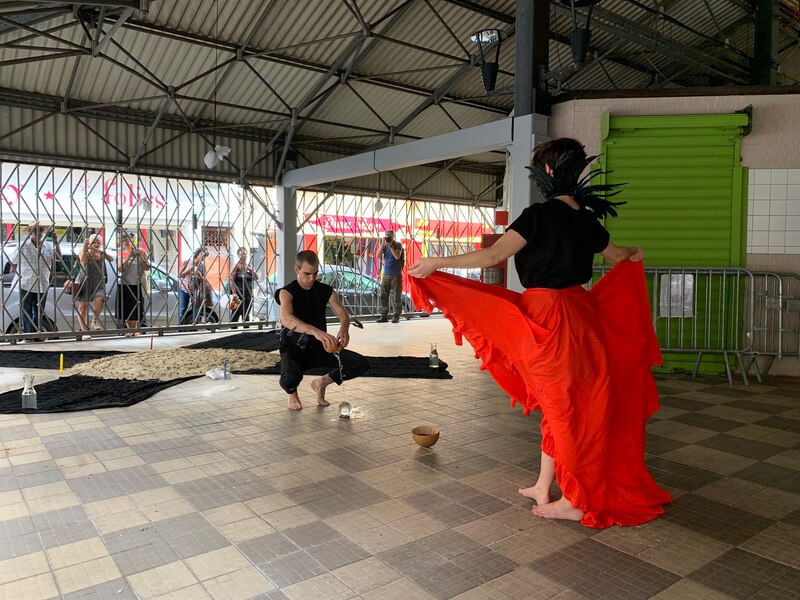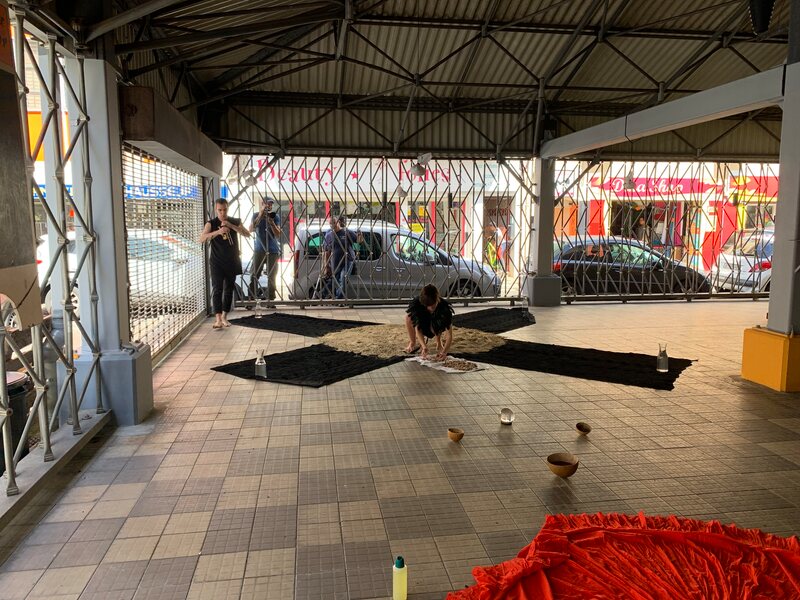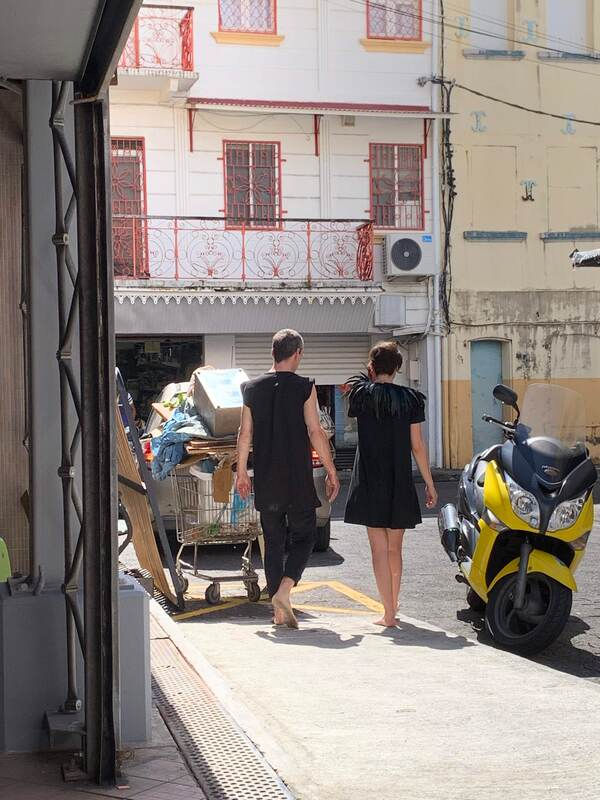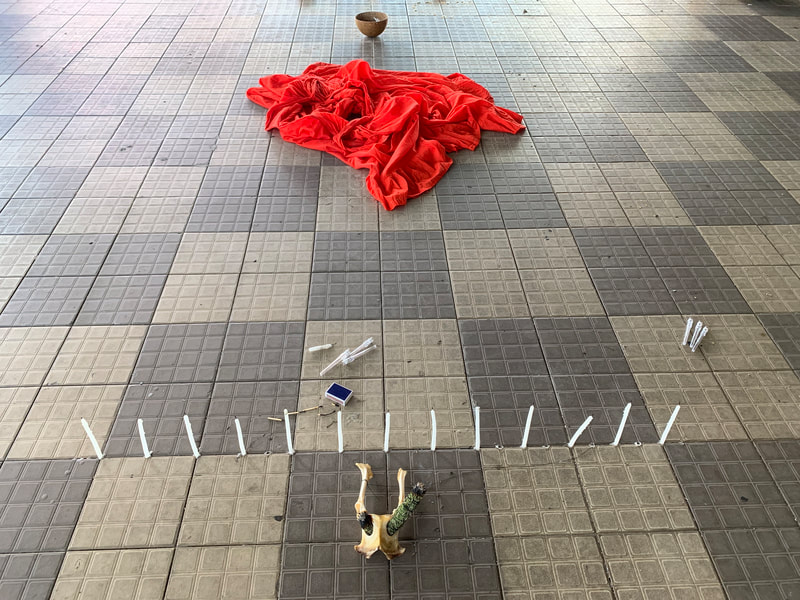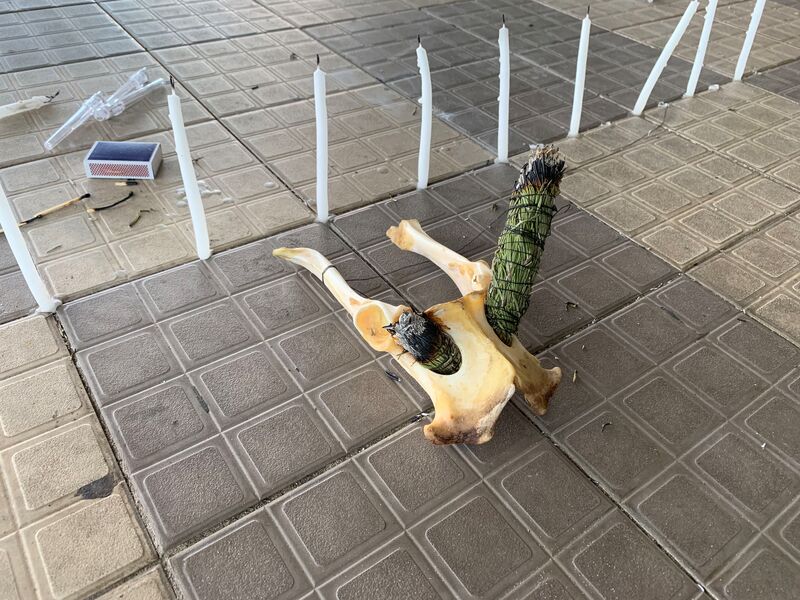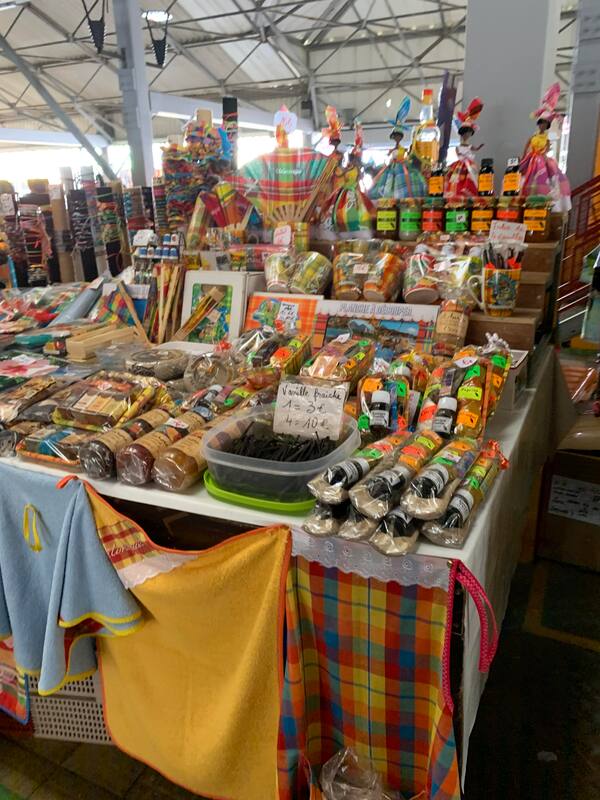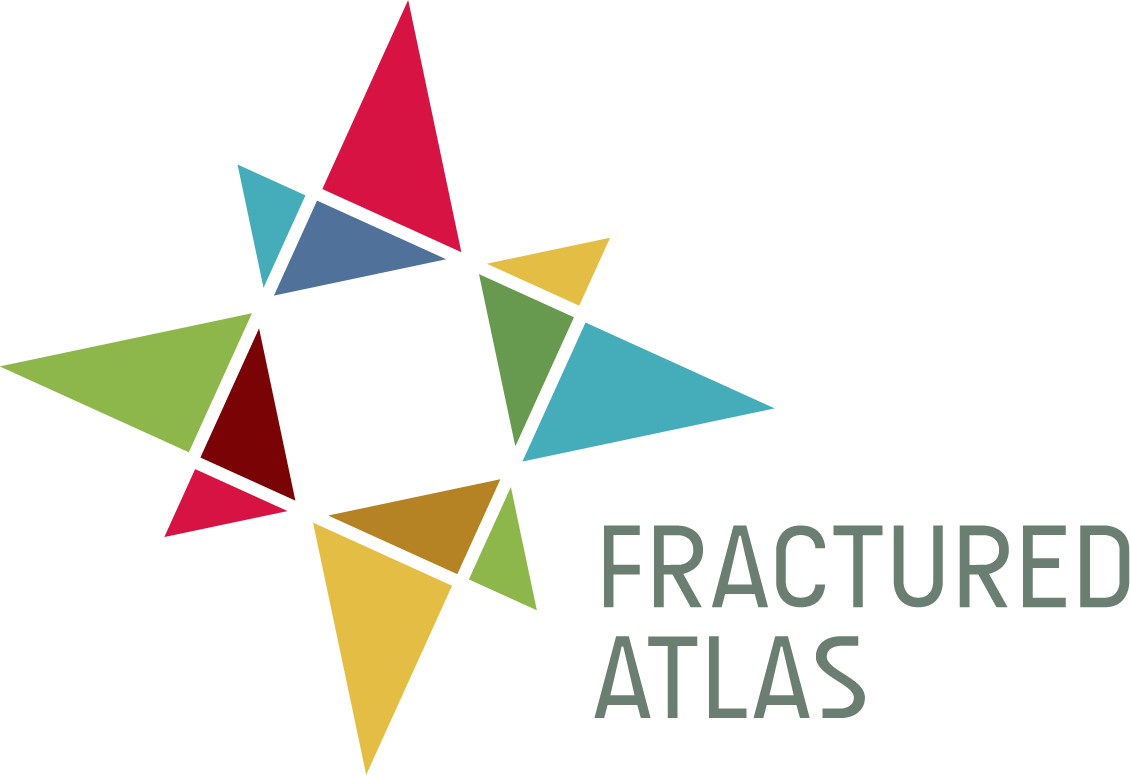|
Interview with Isil Sol Vil and Marina Barsy Janer
November 12, 2019 Fort de France, Martinique International Performance Art Festival (FIAP) By Quinn Dukes Isil Sol Vil (Catalonia) and Marina Barsy Janer (Puerto Rico) presented a ritual based performance within Martinique’s Grand Marché during FIAP 2019 curated by Annabel Guérédrat and Henri Tauliaut. The Grand Marché serves as a central hub for the local community. Unfortunately, the market experienced an electrical fire the week prior to the festival thus requiring the performers to adjust their original vision. Isil and Marina’s thoughtful work, Islas Cicatrices, opened portals and called out to spiritual energies to reassert magic and reject the assertion of humans as only producers. On the final day of the FIAP festival, I interviewed Isil and Marina about their performance, Islas Cicatrices. We opened our discussion with an analysis of the performance objects (see list below) activated throughout the piece and the importance of their geographic origin. You can experience the interview on our podcast channel or via redacted transcription below.
Quinn: I would love to hear more about the materials that you used for your performance. As a viewer I knew that the materials were important and I wasn’t correct in identifying them. It carries a very different meaning in having a context of the materials. I think it is important for our audience to know that you were not just finding materials locally but that you were also bringing them from places that are really important to you.
Marina: Okay, so basically, this piece, to sum it up briefly is the dialog between two cultural and spiritual resistances that we are bringing together because of our own different origins. I am from Puerto Rico and Isil is from Catalonia. So basically, these materials had to do with these rituals or the understanding of spirituality that were in dialog. Not like a fusion but more of a dialog between them. And the materials that Isil performed with were brought from Catalonia. So specifically talking about spiritism and all of the practices that witches were doing. Including the knowledge of plants and of nature. Basically the 3 elements that we were dealing with in terms of the Iberic spiritualities. Isil: (translated by Marina) The use of the crystal ball is used by the espiritistas to connect with other intangible bodies that are no longer with us. Also, the herbs were rosemary, and were gathered from a mountain, called “Witch Mountain.” (Referred to this) because witches used to gather on this mountain. We went there to pick the rosemary and bring it here (Martinique). And the use of this herb is to open, opening doors, opening space, open the mind, the body to connect to other things. The different waters were sea water, rain water and regular tap water. Marina: Sulfur was the other element used that we actually found here. It is also an element that is found in all of these places where witches were persecuted. We understood that they all have this similarity and that they are places where natural sulfur water is coming out. So this was an element that they used so we definitely wanted to use this sulfur – which was the yellow powder that Isil mixed with one of the waters. Isil: It serves to clean the skin. It is cleaning the inside and the outside of the body. Marina: Yes, you can also drink it and it cleans. So, it is a cleansing element. And then the other elements were more from let’s say, my side. So the spiritualities. Especially referring to those that were brought over from the enslaved people. There were different mixes happening. So, in Puerto Rico we have a lot of influence from the Santería which is already a hybrid religious background that is a fusion of Yorùbá culture with Catholicism but in terms of survival and strategic use. And I was bringing forward the energy of four orishas. There was a circle of local sand created and 4 candles on each side with 4 colors, which were the 4 orishas. Also some of the elements had to do with these orishas. There were 2 female and 2 male orishas, although gender classifications are not really (recognized) in Yorùbá culture. But, they do have a strong feminine presence and then a masculine presence - although in hybridity and constant change. We had Yemoja, which is the orisha of the sea and there was the blue candle and then we had sand and water of the sea to bring her essence there. Then there was Oshun, who is the Mother of Sweet waters that is the yellow candle. She also is the element of honey. And she represents sensuality and sexuality in an empowering sense. Then there was Shango which is a warrior. There was the red candle and he is also a dancer. So when I put the skirt, which is a skirt used for the Bomba dance – which is an Afro-Puerto Rican dance, I danced the four spaces to open these portals. This was also in general, inhabiting this energy of Shango. And then Elegguá which was the white candle, that (signifies) the opening of doors and the opening of paths. So already the four stages were already opening paths, but in the very end of the performance, I have a key that is always with me. I take it out and I bury in the very center of the spiral so that was Elegguá opening his paths. Then we have the element of the sugar - the white bags that had the white sugar coming out. That was something that we wanted to bring into the whole ritual because it (represents) how many lives were killed or sacrificed for sugar. So we know that the whole Caribbean had sugar plantations. So this was also why when I was in one space and then I left, then Isil came to make the absence/presence of this body through the pouring of the sugar. And then the shells were used as a forecast of what is your reality in that moment. So throwing the shells is something used in Yorùbá culture to both see and foresee. Isil: I also use my blood as the purist part of my body. It is not a macabre act, it is humble and loving. It is an offering and opening of the body.
Quinn: What is the significance of opening the performance with piercings?
Marina: So the beginning of the ritual was literally the opening of the body and of the skin. Opening through the rosemary and this connection that was already talking about the blood although we didn’t see the blood until the end when its offered once he goes into the sand spiral. Also, blood has a lot of Ashe, which is the power of life for the Yorùbá in Santería, so it’s very powerful. It already carries a lot of energy. The blood became an element and a very important point in the action. Quinn: Did you decide to perform in the market or if that was decided for you? Marina: This was a whole conversation and a bit of a tense situation in terms of things that changed. Originally, the festival told us the different spaces that they had available and we chose the market but it was the closed market. So, it wasn’t the market during the activity of the market- it was the market during the night. It was still open because people could go in, but you don’t have the sellers there. The original action was actually different in terms of aesthetic. Many of the things that happened were happening in the original version let’s say. But there were changes for example, we had “X” of black cloth and then sand on top of the circle for the performed version. In the original, we were on two levels and then the cloth was going down towards the circle and then Isil was going to throw water from the top. So different, very different in that sense. So in terms of the action itself needed to change but then also, in terms of the space, it needed to change. The day before we went into the market and saw the reality of the market – that there wasn’t space for us to do this. Our intention wasn’t at all not to impose ourselves, on the contrary. So we understood that the way the market was distributed, we couldn’t do this installation there. But there was this other part that was the burnt part and some establishments were closed- because some establishments were closed, we had this area free. Quinn: You’re referring to the fire that happened in the market the week before? Marina: Yes. The fire is what caused the changes (to the performance). Because the festival then could no longer offer the market during the night because they didn’t have electricity. Quinn: Right. Marina: So, it was a last-minute thing. But then, as we know from the performance, being there during the day provoked a lot of other things for the people around. Had it happened in the night, it would have been different. We considered this as another layer of reality which was very important for the work. Because it was already creating another dialog. Because we knew we were opening many things energetically, it was also felt by many people. The reaction was different. Isil: (translated by Marina) The day before at the market (which was our only day available to be in the market), we spoke to the people in the market. Trying to find solutions and possibilities on where this action could occur. So, most of them were informed and they knew something was going to happen there. Marina: So this was the history of how it ended up being there, during the day at 12, in the middle of the market. So that was the reason. Quinn: Have you experienced as performers, not just in this festival, that sort of change before? Marina: Oh yes, for different reasons, the circumstances change. And obviously, performance is something alive so it is changing constantly. Sometimes the work is telling you what it needs. It’s also a dialog with the creation. Isil: It’s not a theatre. It’s rapidly changing. Quinn: I was wondering if you have visited Martinique before? Marina: No, this is the first time. Quinn: You explained how the performance in the market caused the performance to shift but do you feel like the space, history and geography of being in Martinique also informed the performance as well? After being here and experiencing it, did it change? Marina: Afterwards or before? Quinn: Well, I guess both! Isil: (translated by Marina) Yes, we did our research before but the experiential research, we did during the few days (prior). Marina: And we had the opportunity to speak about the situation of Martinique with Annabel and Henri some time ago as well. Quinn: What specifically do you mean by situation? Political situation? Social situation? Marina: Yeah, political and social situation. Which in general we are very interested in for our work. We are dealing with these issues all of the time, even if they aren’t evident. Quinn: During the performance, you were opening up so many portals, now that is a part of the market. Do you feel that is an offering or a gift to the place where you were performing? Or do you feel that you have completely closed the portal when you are done and then the energy leaves? Marina: Well actually the last action was, if it wasn’t open enough, it was opening completely with the key that was opening it from the center. So, I think definitely it wasn’t something that was just happening there and then closing back again but something stayed open and vibrant within the space. Isil: While I was going around with the smoke, the focus was towards opening the portals. The action with the cape was expanded and destroyed the focus. It diluted the focus and expanded the portals. It was concentrated inside at one point with the key and then expanded. Quinn: So how do you feel the performance and the rituals of the performance, how are those political? Isil: The capitalist system is not even considering the spiritual body. And it is only considering the machine body and the body for production. Marina: There is a very wonderful book that is talking about this by Silvia Federici’s called The Caliban and the Witch (focused in Europe)- where she explains how the practice of the witch hunt needed to happen in order for capitalism to develop. So how did this magical body that was a part of everyone-so it wasn’t only an idea that some women had, it was already in society. This needed to change radically so that people understood that their body was not magical, it didn’t have powers and it is only for production. It gives me goose pumps. This is a historically reality. So already, bringing the spiritual body and the magical body to any sort of action is already political. And specifically, these two combinations from Afro Puerto Rican heritage and witch heritage, they have been persecuted in their times and controlled and literally vanquished in the witch hunt. It was interesting that one of the ladies in the market, as later explained to us by other people, is that the rituals here (in Martinique) are private rituals. So you can’t do them publicly. I’m not talking about Catholicism or Christianity, I’m talking about these other rituals. Something that we didn’t know, is that their rituals were private. But they are openly selling herbs in the market. There is a lady selling different herbs and knows exactly what they are for. So, she has all this knowledge of herbs and they are selling sulfur and so many things that are not only used for medical healing but also spiritual healing. So this is also happening in this market. I think this market is really a powerful market and wonderful. So it was really an honor to do this action here. Also they had things for healing the body. Isil: For cleaning the blood and different pains. Quinn: So really there was a synergy. Marina: They (the market salespeople) were only telling us the medical healings of these plants. But I’m sure they also use it for other types of healing. So lets say, this body, the “production body”, I think is not so instilled here as a form of resistance. So, they still have this knowledge. I mean that is beautiful. They are just doing it there with the people from the market. Even if they weren’t there, it didn’t mean that they went there to see the action. They were already doing their action that was selling the products that is very important. It was a really wonderful market. When we went there, we were really surprised at the type of products that they have. We were like, “Wow!” The Moringa- there is this tree that is also a healing tree and they had this mashed thing of this tree. Wow, this is accessible here. In Puerto Rico this is not that accessible so it was really nice and to experience that. Quinn: It’s amazing to hear those reflections from your point of view. Something that I was wondering is what brought you together to present performance and did you present performances before as individuals before the collaborative work? Marina: Well, love brought us together. Quinn: That’s wonderful! Marina: The philosophy or methodology that we use is subversive love and extreme care. So actually, you talking about this care-taking of the performance. This extreme care is something that we work through our lives and our performance because the two do not divide. And I think this connection wouldn’t be possible if we didn’t have this great affection for each other. We did work as individual performers before and we still do some work individually. But since 2015 when we met, we met in performance. It was very beautiful and has been a part of our relationship since the beginning. Quinn: Do you find the hybrid life of your personal relationship together and performance difficult in there not being a boundary? This being life, this being art, this being business. Isil: No, not at all. Marina: As we said, it couldn’t be possible without this relationship. It’s one of our many ways of communicating and being with each other. So being in performance is another layer. We also do our own rituals in our house. It is a part of our life – this way of being. Isil: This performance could have happened in our house. Marina: And actually, our first year of performing together. We didn’t do any action for the public. It was all intimate action that we decided to film but as an extra. (Thinking) If then the film works something then we edit and we share it. The whole first year was doing these actions for ourselves, very intimate actions without anyone else seeing it in that moment. Quinn: And, you were doing those actions to see how you “worked” together? Marina: No, not thinking about work. We did it because, we felt we needed to do it. (Translates to Isil) Isil: (translated by Marina) It was impulsive and another way of relating. When you make love to a person then you make love in other senses as well. When you talk to a person then you have a dialog in another way. So, it was more like that. Marina: We once shaved each other’s hair, so we were without this layer. Isil: For feeling the skin. Later we went to a very beautiful forest in Catalonia and buried each other. Marina: So together, we were in fetal position and were just breathing in the earth. This was like being reborn. Quinn: Sounds wonderful. Marina: Yeah, (We thought) "I want to do this with you to see how it feels." It was very natural. "I think we should be without these hairs that we have". The skin feels different so you are more in contact with the person. This is an example of the processes we’ve had. Quinn: When I was reading about you, before coming here. Reading your bio and statement. I was just trying to understand the statement and what it meant for you. Now it is so much meaningful and to hear why you engage in these actions together. There is an honesty and you are very interconnected with your bodies and spiritually and it is really amazing to see two performers come together in that way. Because it is quite rare. Isil and Marina: Thank you. Quinn: Thank you so much for your time. It was amazing to meet you both. ISIL SOL VIL X MARINA BARSY JANER
|
|
Performance Is Alive is a fiscally sponsored project of Fractured Atlas, a 501(c)(3) charity. Contributions made payable to Fractured Atlas for the purposes of Performance Is Alive are tax-deductible to the extent permitted by law.
DONATE TODAY! |
CONTRIBUTORS
Ian Deleón
Quinn Dukes
Alexandra Hammond
Luke Mannarino
Polina Riabova
Sarah G. Sharp
Alex Sullivan
Archives
July 2023
August 2022
November 2021
October 2021
September 2021
May 2021
March 2021
January 2021
December 2020
November 2020
September 2020
April 2020
January 2020
December 2019
November 2019
October 2019
September 2019
August 2019
July 2019
June 2019
April 2019
March 2019
February 2019
December 2018
November 2018
October 2018
September 2018
August 2018
July 2018
June 2018
May 2018
April 2018
March 2018
February 2018
January 2018
November 2017
October 2017
September 2017
July 2017
June 2017
May 2017
April 2017
March 2017
February 2017
January 2017
November 2016
September 2016
July 2016
June 2016
May 2016
April 2016
March 2016
February 2016
January 2016
December 2015
November 2015
October 2015
September 2015
August 2015
July 2015
June 2015
May 2015
April 2015
March 2015
February 2015
January 2015
December 2014
November 2014
